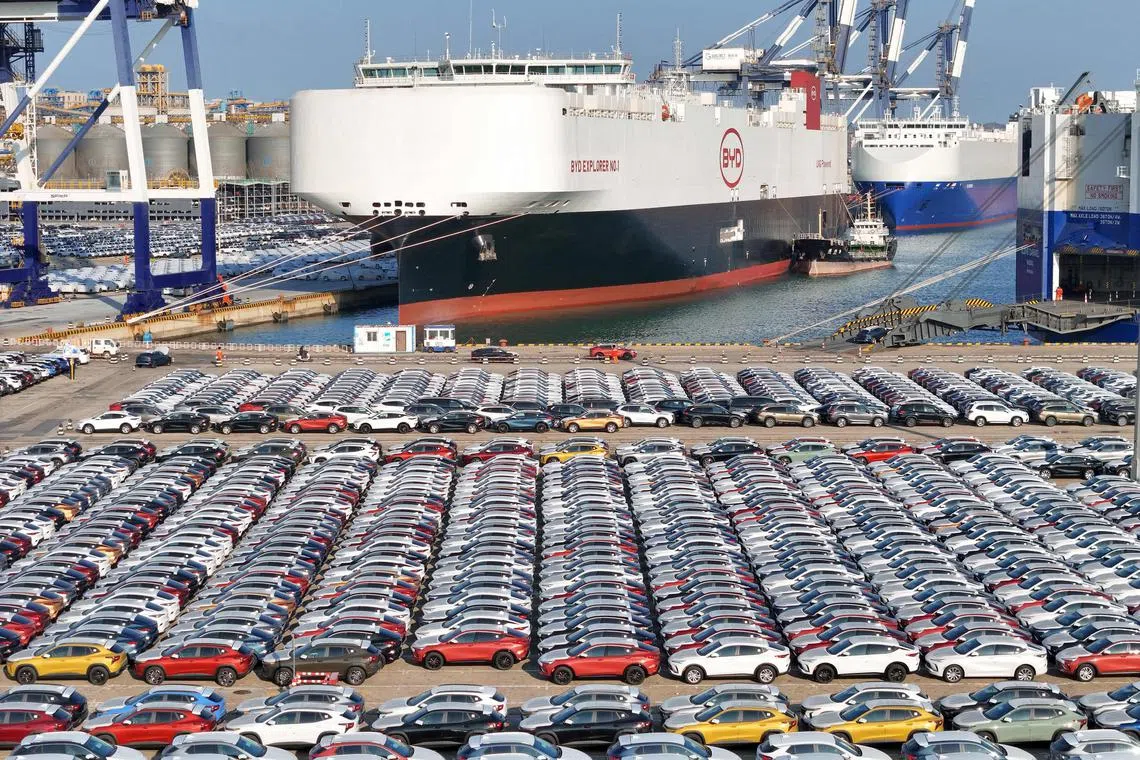China exports rise, but falling imports dampen June trade data
Sign up now: Get ST's newsletters delivered to your inbox

Data suggests manufacturers may be front-loading orders in anticipation of tariffs from more countries.
PHOTO: AFP
Follow topic:
BEIJING - China’s exports grew at their fastest pace in 15 months in June, suggesting manufacturers are front-loading orders ahead of tariffs expected from a growing number of trade partners, while imports unexpectedly shrank amid weak domestic demand.
The mixed trade data keeps alive calls for further government stimulus as the US$18.6 trillion (S$25 trillion) economy struggles to get back on its feet.
Analysts warn that the jury is still out on whether strong export sales in recent months can be sustained, given major trade partners are becoming more protective.
“This reflects the economic condition in China, with weak domestic demand and strong production capacity relying on exports,” said Pinpoint Asset Management chief economist Zhang Zhiwei.
“The sustainability of strong exports is a major risk for China’s economy in the second half of the year. The economy in the US is weakening. Trade conflicts are getting worse.”
Outbound shipments from the world’s second-biggest economy grew 8.6 per cent year on year in value in June, Customs data showed on July 12, beating a forecast 8 per cent increase in a Reuters poll of economists and a 7.6 per cent rise in May.
But imports hit a four-month low, shrinking 2.3 per cent compared with a forecast 2.8 per cent increase and a 1.8 per cent rise the previous month, highlighting the fragility of domestic consumption.
Stronger-than-expected exports have been one of the few bright spots for an economy otherwise struggling for momentum despite official efforts to stimulate domestic demand following the pandemic.
A prolonged property slump and worries about jobs and wages are weighing heavily on consumer confidence.
Still, as the number of countries stepping up curbs on Chinese goods increases, so too does the pressure on the country’s exports to prop up progress towards the government’s economic growth target for 2024 of around 5 per cent.
China’s trade surplus stood at US$99.05 billion in June, the highest in records going back to 1981, compared with a forecast of US$85 billion and US$82.62 billion in May. The United States has repeatedly highlighted the surplus as evidence of one-sided trade favouring the Chinese economy.
Washington in May hiked tariffs on an array of Chinese imports, including quadrupling duties on Chinese electric vehicles to 100 per cent. Brussels last week confirmed it would impose tariffs on EVs as well, but only up to 37.6 per cent.
Chinese exporters are also on edge heading into US elections in November in case either major party tips fresh trade restrictions.
Turkey in June announced it would impose a 40 per cent additional tariff on Chinese-made EVs and Canada said it was considering curbs.
Meanwhile, Indonesia plans to impose import duties of up to 200 per cent on textile products, which come mainly from China. India is monitoring cheap Chinese steel and talks with Saudi Arabia over a free trade agreement have reportedly stalled over dumping concerns.
Depressed domestic demand
The miss on imports might not bode well for exports in the coming months as just under a third of China’s imports are parts for re-export, particularly in the electronics sector.
China took in only slightly more chips in June in volume terms than it did a year earlier, suggesting its heavy investment in expanding production of older chips – which are known as legacy chips and can be found in everything from smartphones to fighter jets – is warping supply and demand.
The European Commission has reportedly begun canvassing the bloc’s semiconductor industry for its views on China’s expanded production of legacy chips, which could constrain the Asian giant’s strong export performance in electronics.
Further signalling weak domestic demand, China’s steel exports in the first half of the year jumped 24 per cent from a year earlier, pointing to a faltering construction sector, which is a heavy user of the metal.
Analysts expect China to roll out more policy support measures in the short term and a government pledge to boost fiscal stimulus is expected to help kick domestic consumption into a higher gear.
Economists and investors are waiting for the Third Plenum to be held on July 15 to 18, with hundreds of China’s top Communist Party officials gathering in Beijing for a meeting that comes every five years. reuters

